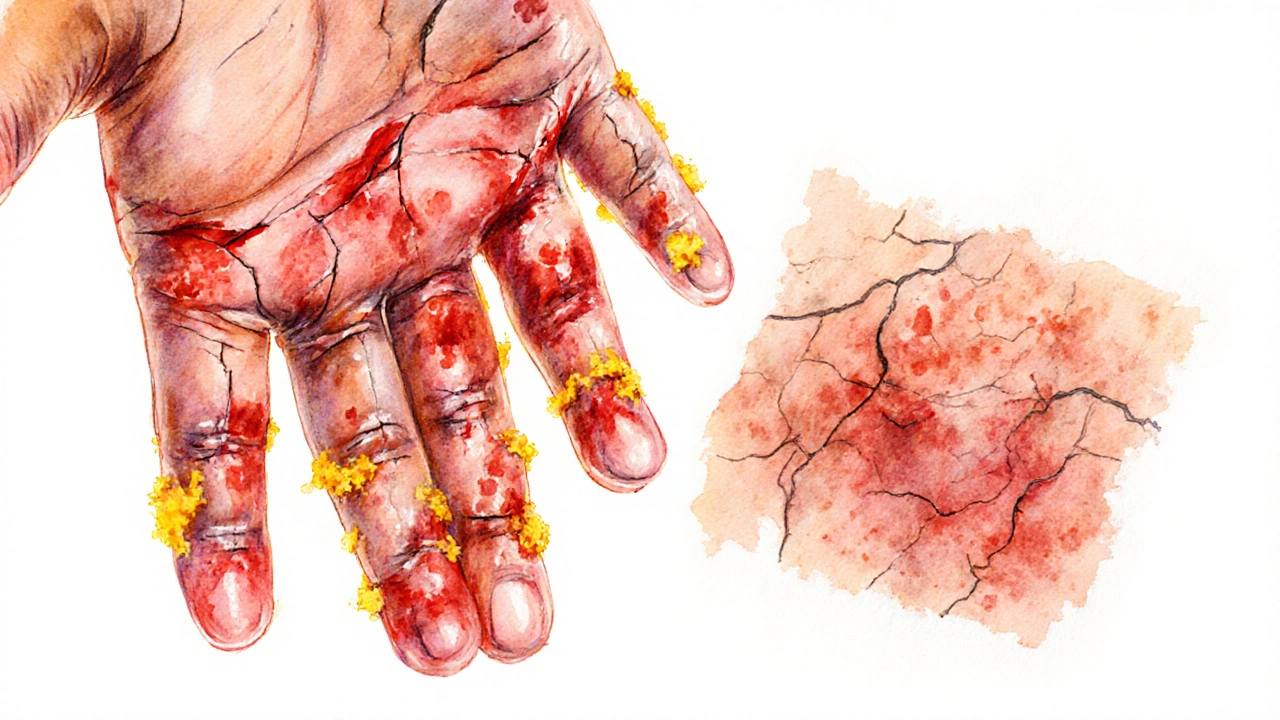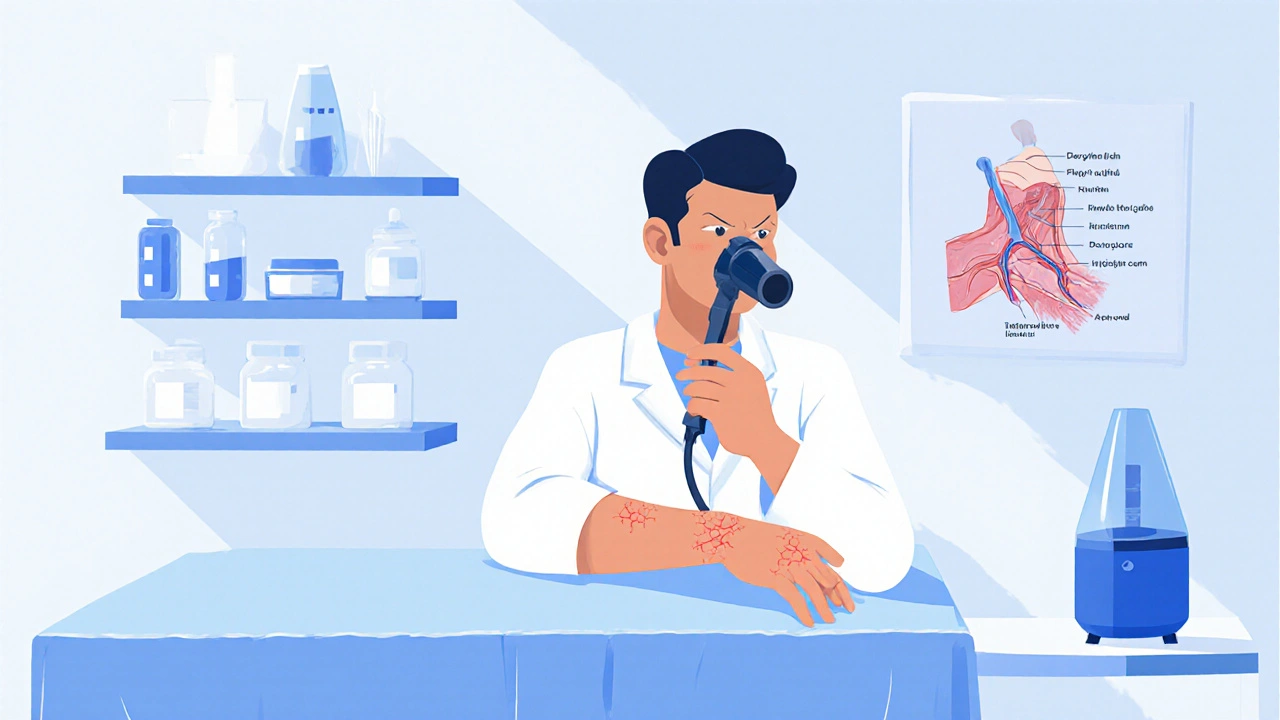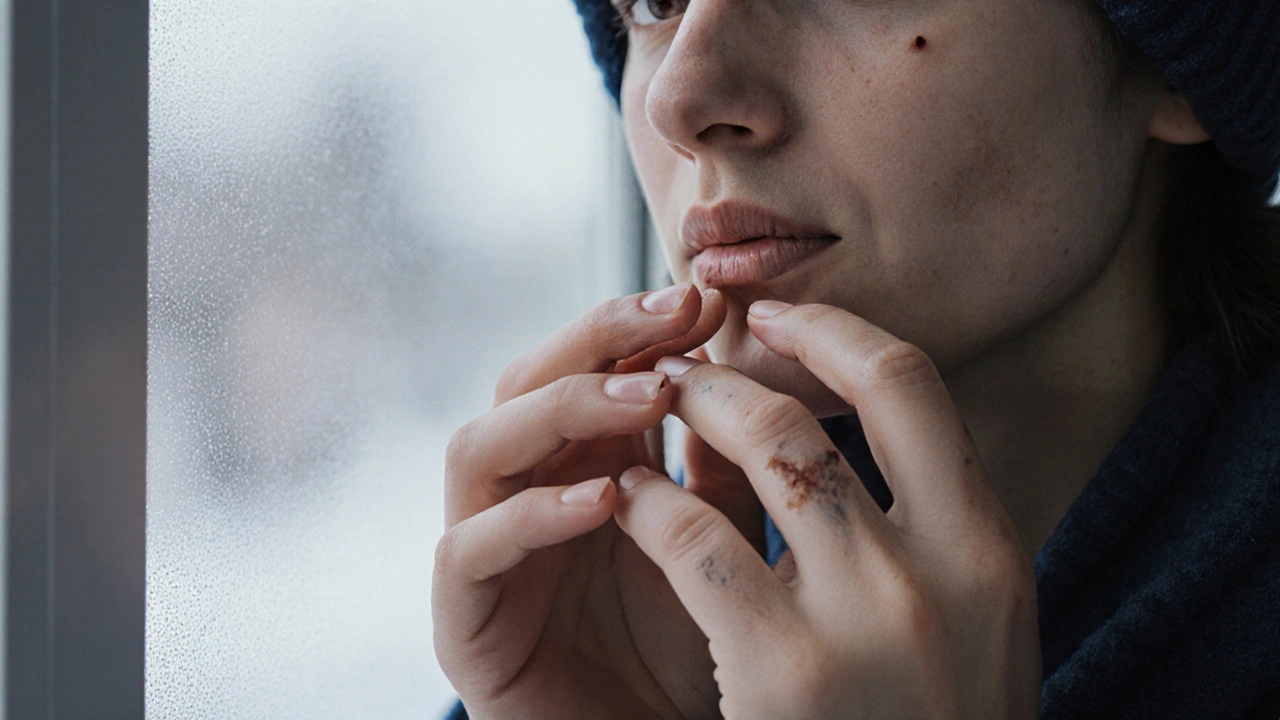Chapped Skin Assessment Tool
Assess Your Chapped Skin Symptoms
Answer these questions to determine if your symptoms warrant a visit to a dermatologist. This tool is based on clinical guidelines from the article.
Red Flag Symptoms
Check all symptoms you're experiencing:
Your Assessment Result
Did you know that nearly one‑third of Australians complain of painful, cracked skin each winter? When a simple dry patch turns into a raw, bleeding line, it’s a clear signal that something more serious might be going on.
Chapped skin is a condition where the outer layer of the skin loses moisture, becomes rough, and may split or bleed. Common triggers include cold air, low humidity, frequent hand washing, and harsh soaps. The skin’s protective barrier weakens, letting irritants slip through and cause inflammation.
When Home Care Isn’t Enough
Most of us can soothe a mild dry patch with a good moisturizer and a few lifestyle tweaks. But there are red‑flag symptoms that tell you it’s time to book an appointment with a skin specialist.
Red‑Flag Symptoms That Require a Dermatologist
- Bleeding or oozing that lasts more than 48hours.
- Intense pain, burning, or swelling around the crack.
- Cracks that reappear within a week despite regular moisturizing.
- Signs of infection - redness spreading, warmth, yellow crusts, or fever.
- Accompanying rash, blisters, or scaling that looks like eczema or psoriasis.
- Cracking on areas other than hands and lips, such as elbows, knees, or the face.
If you notice any of these, it’s best to see a Dermatologist a medical doctor who specializes in skin, hair, and nail disorders. They can pinpoint the cause and prescribe treatments that over‑the‑counter products can’t match.
Underlying Conditions That Mimic or Worsen Chapped Skin
Sometimes what looks like simple dryness is actually a symptom of another skin condition:
- Eczema a chronic inflammatory skin disease that leads to itchy, scaly patches often starts on hands and can make them crack easily.
- Psoriasis an autoimmune condition causing thick, silvery scales that can fissure may appear on elbows, knees, and scalp, increasing the risk of cracking.
- Contact dermatitis an allergic or irritant reaction that inflames the skin after exposure to chemicals or metals can turn a dry patch into a painful crack within hours.
- Fungal infections such as athlete’s foot can spread to the hands, especially after a moist environment.
- Vitamin deficiencies-particularly A, D, and E-can weaken the skin barrier.
Identifying these root causes is why a professional evaluation matters.

What to Expect During Your Dermatology Visit
A dermatologist will start with a visual exam and ask about your daily habits, medical history, and any products you use. They may perform one or more of the following:
- Patch testing to uncover hidden allergies.
- Skin scraping or culture if an infection is suspected.
- Prescription of stronger Moisturizer formulations containing ceramides, urea, or petrolatum for deep barrier repair.
- Topical Hydrocortisone a mild steroid that reduces inflammation and speeds healing of cracked skin or higher‑strength steroids if needed.
- Antifungal creams or oral medication for fungal involvement.
- Advice on lifestyle changes such as humidifier use, glove protection, and product selection.
Having a clear picture of the likely cause helps you and the doctor choose the right treatment plan.
Preparing for Your Appointment - Make It Count
- Write down when the cracks started and what makes them worse.
- Take photos of the worst areas; skin changes can be subtle between visits.
- List all over‑the‑counter lotions, soaps, and hand sanitizers you use.
- Note any recent changes in diet, medication, or work environment.
This prep saves time and ensures the dermatologist gets the details that matter.
Effective Home Care While You Wait
Even if you’re planning a visit, there are steps you can take right now to stop the cracking in its tracks:
- Swap hot showers for lukewarm water; hot water strips natural oils.
- Pat skin dry instead of rubbing, then apply a thick Moisturizer within three minutes to lock in moisture.
- Use a humidifier in bedroom during winter; aim for 40‑60% humidity.
- Wear cotton gloves under rubber or latex gloves when doing chores that involve water.
- Avoid scented soaps, alcohol‑based hand sanitizers, and harsh exfoliants.
If the skin is already bleeding, gently clean with mild soap and apply a thin layer of petroleum‑based ointment to form a protective barrier.

Comparison: Mild vs. Severe Chapped Skin
| Feature | Mild (Home Care) | Severe (Professional Care) |
|---|---|---|
| Appearance | Dry, flaky patches; small cracks that don’t bleed. | Deep fissures, bleeding, oozing, or crusted lesions. |
| Pain level | Occasional itching or mild tightness. | Persistent burning, throbbing, or sharp pain. |
| Duration | Improves within a week of moisturizing. | Persists >2 weeks despite regular moisturization. |
| Additional symptoms | Little to no redness or swelling. | Redness spreading, swelling, fever, or signs of infection. |
| Action | Apply thick moisturizer, use humidifier, avoid irritants. | Schedule dermatologist visit; may need prescription steroids, antifungals, or allergy testing. |
Quick Checklist Before You Call
- Is the skin bleeding or oozing?
- Has the problem lasted longer than 14days?
- Do you have fever, swelling, or spreading redness?
- Are there other skin conditions (eczema, psoriasis) involved?
- Have home remedies failed despite consistent use?
If you answered “yes” to any of these, make an appointment now.
Frequently Asked Questions
How long can I safely use over‑the‑counter moisturizers?
You can apply a fragrance‑free, ceramide‑rich cream several times a day indefinitely. If the skin isn’t improving after 7‑10 days, it’s time to see a dermatologist.
Can I use hydrocortisone on cracked skin?
A 1% hydrocortisone cream can reduce inflammation for up to 7days, but it should not be used on open wounds without medical advice.
What’s the difference between eczema and simple chapped skin?
Eczema is a chronic condition with itchy, inflamed patches that often recur, while chapped skin is usually a temporary loss of moisture. Both can crack, but eczema usually requires prescription treatment.
Should I avoid hand sanitizers during a flare?
Yes. Alcohol‑based sanitizers strip the skin’s natural oils. Opt for a gentle, fragrance‑free soap and wash hands with lukewarm water.
Can diet help heal cracked skin?
Foods rich in omega‑3 fatty acids (salmon, walnuts) and vitamins A, D, E support skin barrier health. Hydration also plays a key role.
Is a humidifier worth the investment?
During dry winter months, a bedroom humidifier set to 45‑55% humidity can reduce skin dryness by up to 30% and is especially helpful for people with recurrent chapped skin.
When should I suspect an infection?
If you see redness spreading beyond the crack, warmth, yellowish crust, pus, or develop a fever, seek medical care promptly. These are classic signs of bacterial infection.
Next Steps
Start with the home‑care checklist today. If any red‑flag symptom appears, call your local dermatologist within the next 24‑48hours. Early intervention not only speeds healing but also prevents chronic skin issues from taking hold.


Andrea Mathias
Listen up, folks! If your hands look like they've been through a sandstorm and they’re still bleeding after a couple of days, that's a red flag louder than a fire alarm. Pour a thick, petrolatum‑based ointment on the cracked area and lock it in with a breathable glove – don't be cheap, use proper medical‑grade stuff. Forget the flimsy fragrances; they’re just sugar coating for the problem. The skin barrier is basically the front line, and when it’s breached, bacteria love to throw a party. Salt‑water baths? No, you need a barrier that doesn’t evaporate in minutes. If you notice swelling, warmth, or any pus, you’ve crossed into infection territory and a dermatologist is not optional – it’s mandatory. Hydration from the inside out matters, so chug water like you’re training for a marathon. Vitamin A, D, and E aren’t just hype; they’re essential for keratinocyte health. And stop obsessing over the occasional dry patch; when it becomes a chronic fissure, you’ve got yourself a medical emergency. Keep that humidifier humming, avoid hot showers, and if the skin still cries out for help, book that appointment now, pronto!
October 12, 2025 AT 15:21
TRICIA TUCKER
Totally agree, Andrea! A good moisturizer with ceramides is a game‑changer. Also, keeping a simple skin‑care journal helps you spot patterns faster. 🌿
October 19, 2025 AT 08:28
Dave Tu
While the article provides a thorough overview, it neglects to mention that many over‑the‑counter hydrocortisone preparations are contraindicated on open fissures due to the risk of systemic absorption. In such scenarios, a prescription‑strength steroid or a non‑steroidal anti‑inflammatory may be warranted. Additionally, patch testing can uncover hidden allergens that exacerbate barrier dysfunction.
October 26, 2025 AT 01:34
Johnna Sutton
Well, let me just say that the mainstream dermatology establishment is deliberately hiding the fact that simple dietary changes can reverse chronic chapping. If you're eating processed junk and neglecting omega‑3s, your skin barrier is doomed. Forget the fad “ceramide creams” – they’re a ploy by big pharma to keep you buying forever. The real cure lies in a low‑sugar, high‑antioxidant diet, plus a daily dose of vitamin D3. And beware of the hidden nanoplastics in many soaps; they infiltrate skin pores and accelerate cracking. Many dermatologists won’t tell you this because they’re paid off by the soap industry. So stop trusting the “official” advice and start re‑evaluating what you put on your skin and into your mouth.
November 1, 2025 AT 18:41
Vinay Keragodi
Interesting article. The part about humidifiers resonates with me – I’ve found that setting humidity to around 45% reduces the frequency of dry patches. Also, applying a thick ointment within three minutes of washing really traps moisture.
November 8, 2025 AT 11:48
Millsaps Mcquiston
Good point, Vinay. For folks on a budget, a simple petroleum jelly works just as well as pricey creams, as long as you reapply after each wash.
November 15, 2025 AT 04:54
Nina Vera
OMG, this is EVERYTHING!! I’ve been dealing with cracked lips for weeks, and the suggestion to use a humidifier literally saved me from looking like a dried‑out raisin. Seriously, thank you for the checklist – I’m printing it and hanging it on my fridge! 🙌
November 21, 2025 AT 22:01
Alan Kogosowski
Let me break this down in exhaustive detail because the nuances matter. First, the skin’s stratum corneum functions as a semi‑permeable membrane, and when it loses lipids, transepidermal water loss skyrockets. Second, the presence of ceramides, cholesterol, and free fatty acids in a 1:1:1 ratio is essential for barrier repair; any deviation disrupts homeostasis. Third, while the article mentions moisturizers, it fails to differentiate between occlusive, humectant, and emollient mechanisms – a critical oversight. Fourth, the influence of environmental relative humidity on the skin’s hydration gradient follows a logarithmic curve, meaning small changes in RH can have disproportionate effects on skin elasticity. Fifth, the role of the microbiome cannot be ignored; Staphylococcus epidermidis and Cutibacterium acnes produce lipids that support barrier integrity, and over‑use of antiseptics can decimate these beneficial organisms. Sixth, topical steroids should be prescribed based on potency rankings (class I–VII), and the article’s generic “higher‑strength steroids” lacks the specificity required for safe practice. Seventh, when infection is suspected, a culture swab should be inoculated on both aerobic and anaerobic media to rule out mixed flora, especially in immunocompromised patients. Eighth, the recommendation to wear cotton gloves under latex when dealing with water is sound, but one must also consider the occlusion‑induced maceration risk; thus, breathable yet waterproof liners are ideal. Ninth, nutrition, particularly omega‑3 fatty acids, vitamin A (in retinoid form), vitamin D, and vitamin E, provides substrates for ceramide synthesis – a point the original piece glosses over. Tenth, the systemic absorption of topically applied urea can be significant when applied to compromised skin, so dosing must be monitored. Eleventh, the article neglects to mention that certain systemic medications-like retinoids, antiplatelets, and chemotherapy agents-can predispose patients to severe xerosis and subsequent fissuring. Twelfth, chronic kidney disease and diabetes mellitus are comorbidities that impair wound healing, thereby exacerbating chapped skin. Thirteenth, etiology of hand dermatitis often includes wet‑work exposure, and barrier creams with dimethicone can provide a protective film without the greasiness of traditional ointments. Fourteenth, the efficacy of humidifiers is contingent upon proper maintenance; mineral buildup can aerosolize calcium carbonate, irritating respiratory passages. Fifteenth, the timeline for improvement with proper regimen averages 7–10 days, but failure to respond warrants dermatology referral. In summary, while the article serves as a solid introductory guide, the depth of pathophysiology, treatment stratification, and patient‑specific considerations necessitate a more comprehensive approach for optimal outcomes.
November 28, 2025 AT 15:08
Ben Lee
Thanks for the deep dive, Alan. I’d add that in practice, patients often respond better to a step‑ladder approach: start with emollient‑rich ointments, assess after five days, then consider topical steroids if needed. Monitoring is key.
December 5, 2025 AT 08:14
David Brice
Yo, this shoud be read by everyone. If you keep using alcholic saniziters you are straight up ruining your skin. Just switch to a gentel soap and slap on some petroleom jell... oops sorry misspelled, but you get the idea.
December 12, 2025 AT 01:21